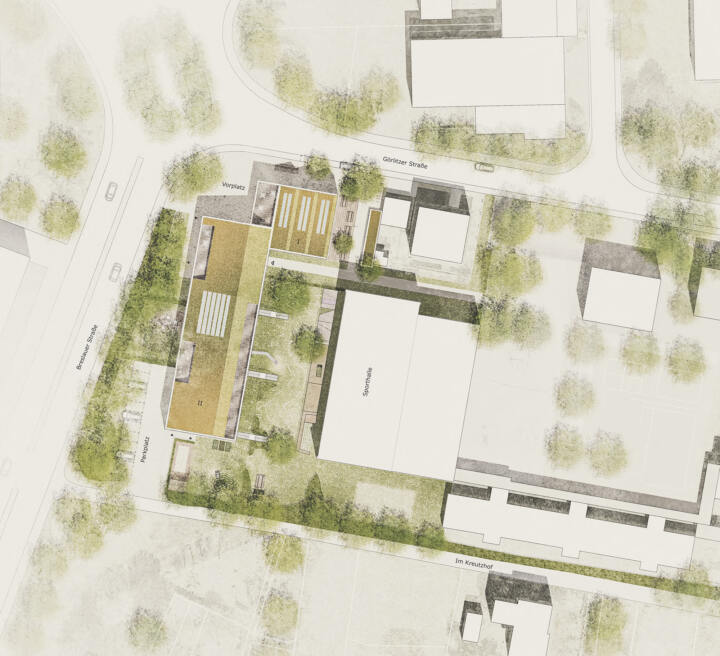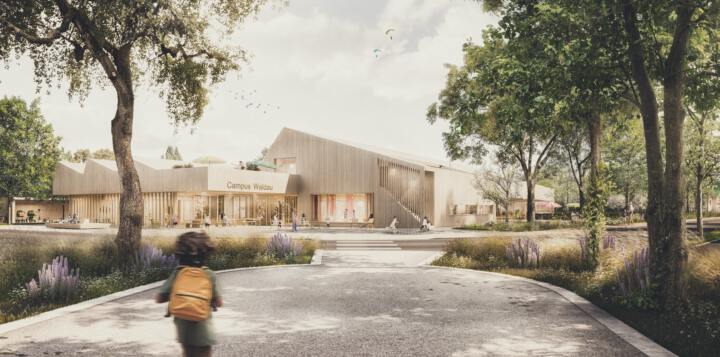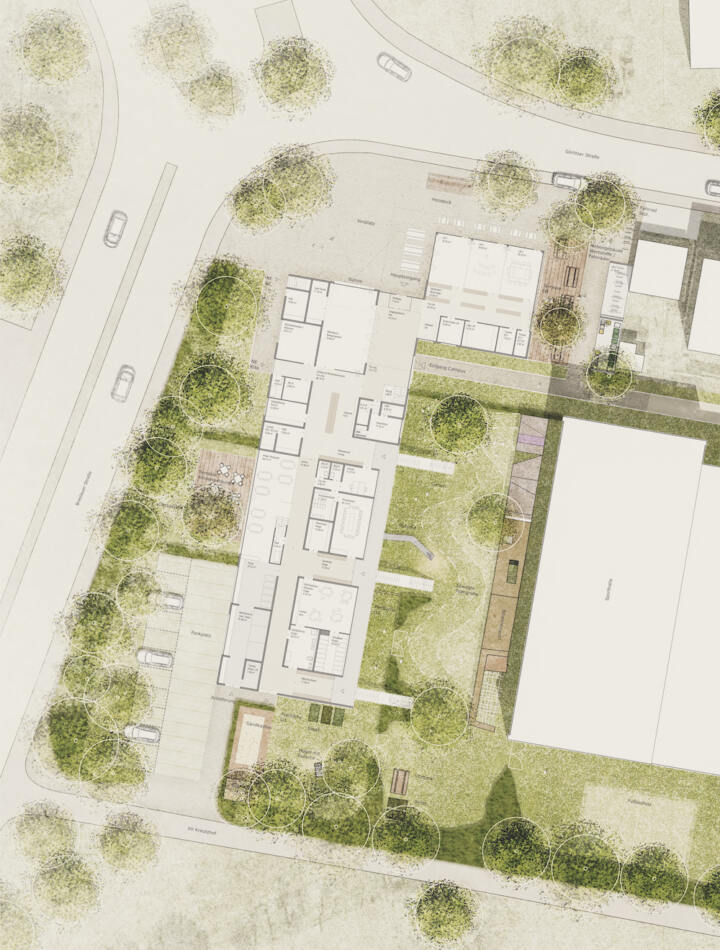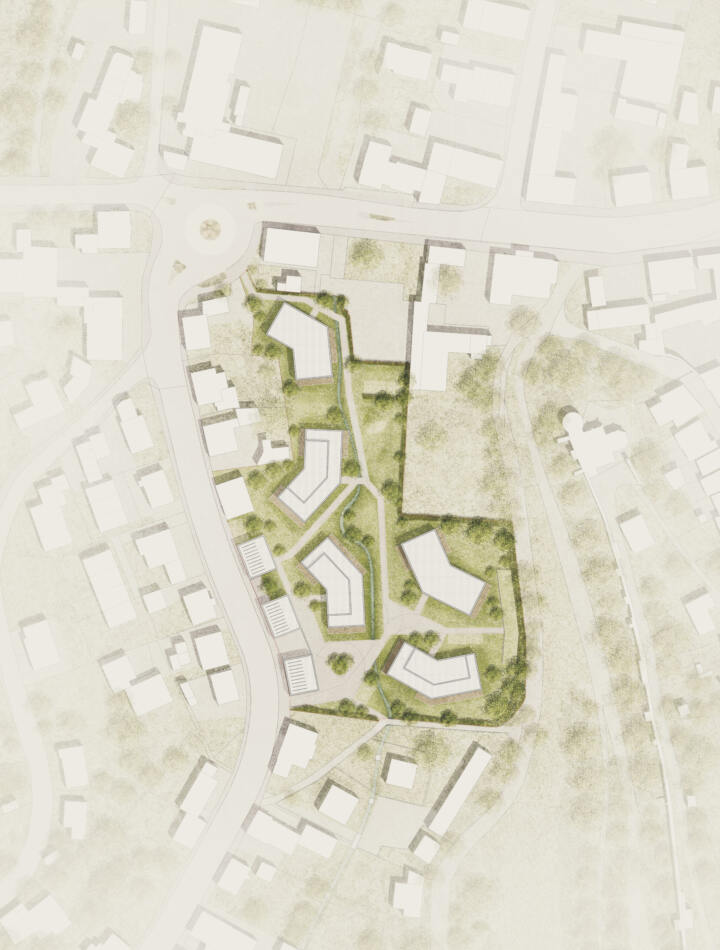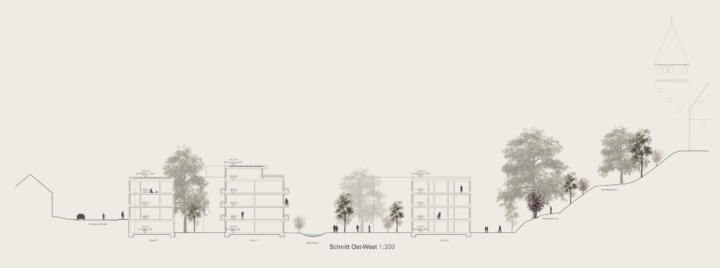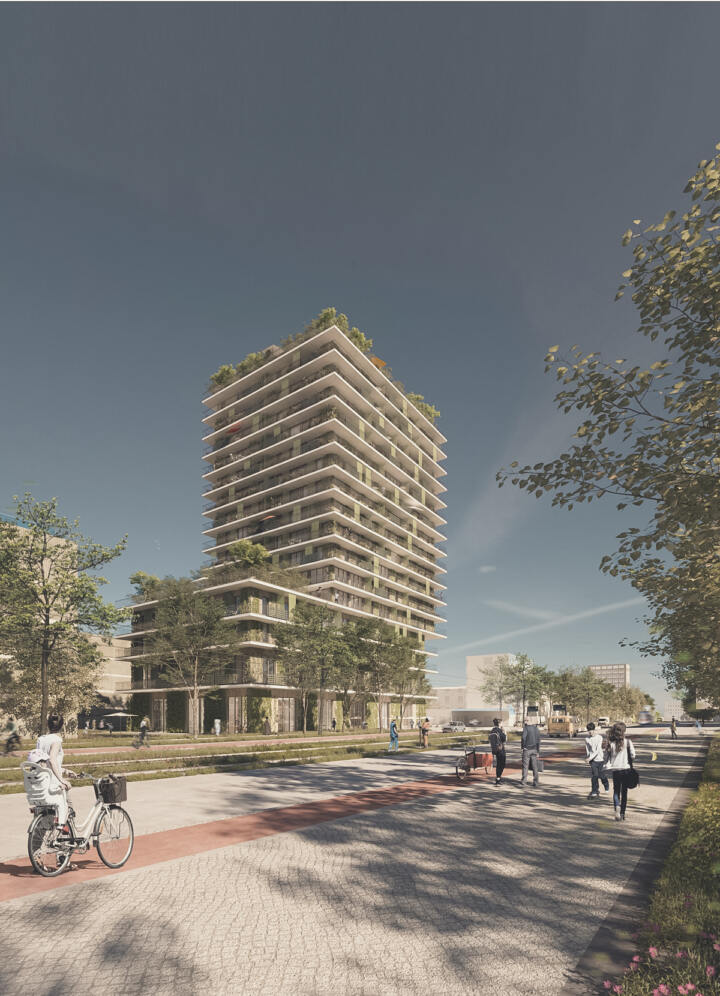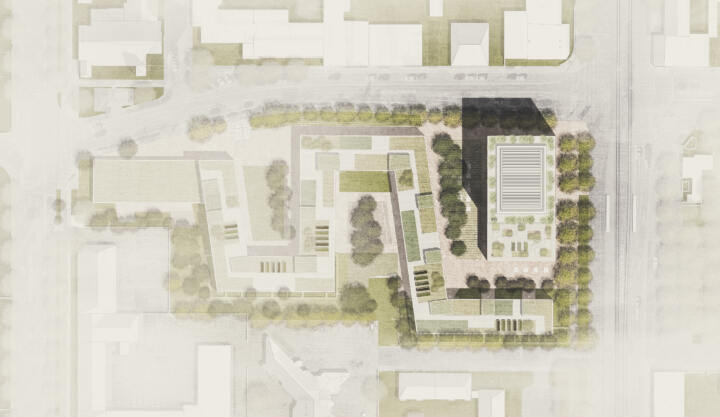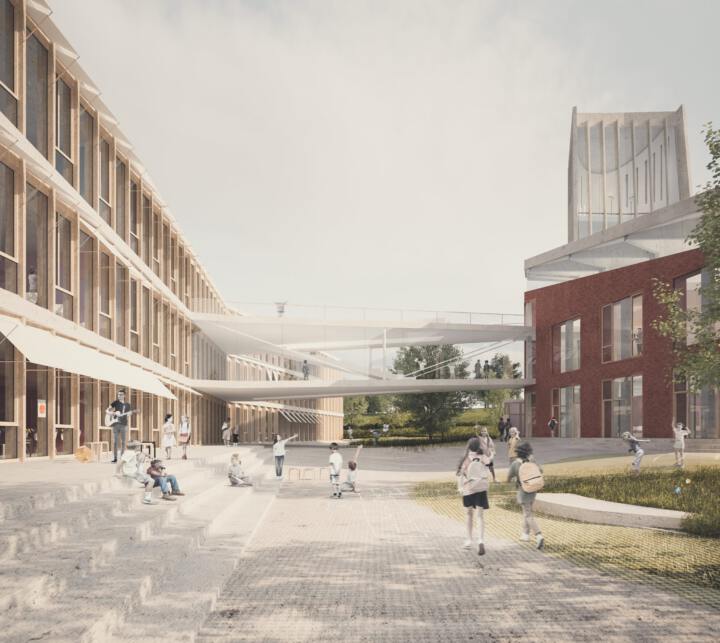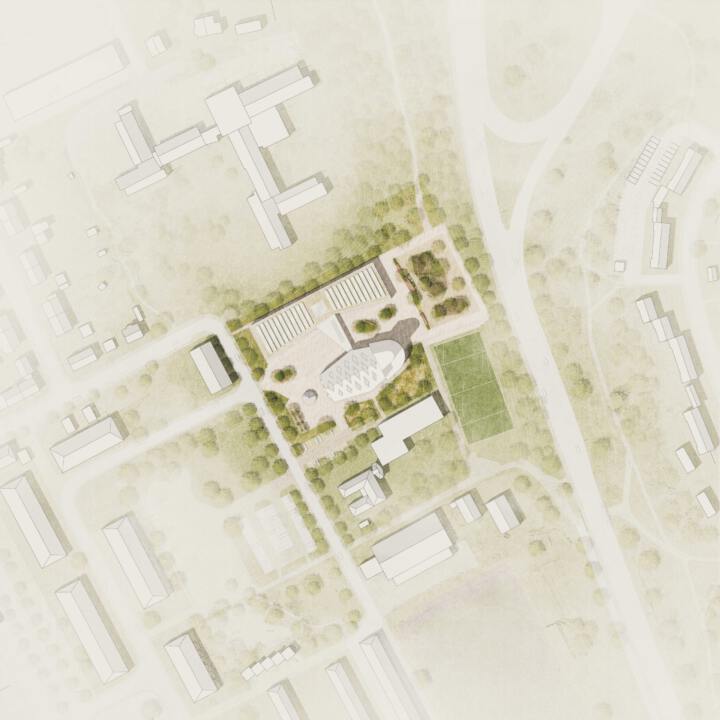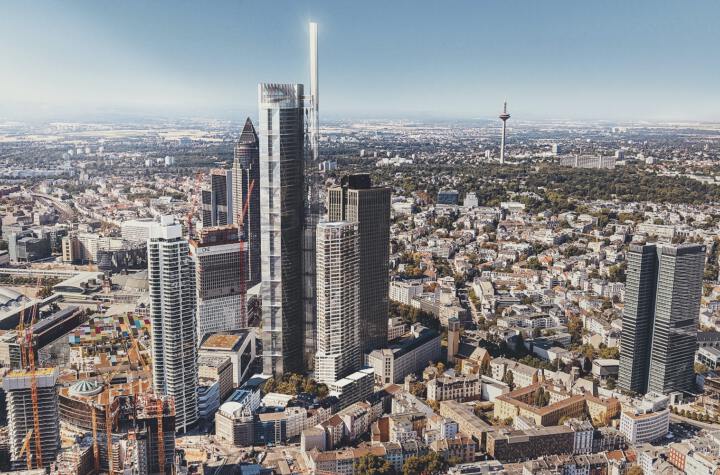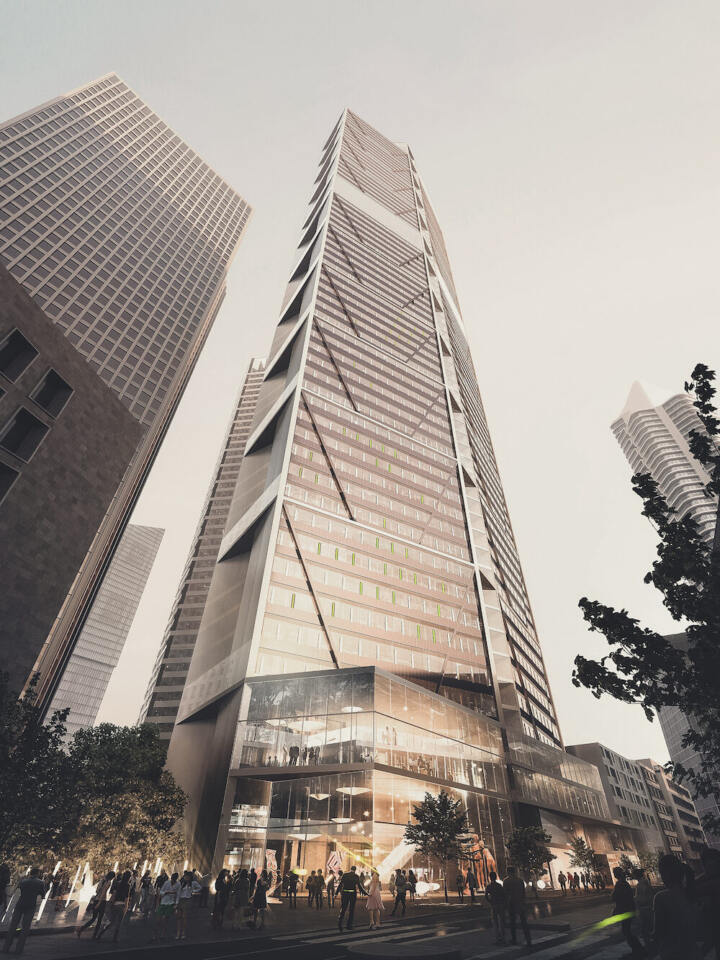Family Center, Learning Workshop and Daycare Center, Waldau Campus | Kassel
1st Prize I Family Center, Learning Workshop and Daycare Center, Waldau Campus
Kassel
In collaboration with pape + pape architekten
The L-shaped building forms two structural angles parallel to the northern and western boundaries of the site, creating an inviting forecourt encompassing an entrance area under a canopy. This attractive outdoor space can be used for big events. Large glazed openings in the learning workshop, in the multifunctional room, and facing the campus grounds generate transparency, allowing the building to enter into direct dialogue with its surroundings.
The building volume and interior layout of the new family centre lay down clear categories and zones within the open space. A spacious forecourt has plenty of room for parents’ daily chat and, when the occasional performance takes place, offer somewhere to meet and talk during the interval. A lounging deck, slightly off to the side, is destined to become a popular meeting place for the kids.
On the quieter east side child-friendly bench-table combinations offer space for doing homework or craft activities outside. Between the new building and the gymnasium there is an outdoor playground and romp area for the daycare children. A linear playground sculpture offers opportunities for all age groups to stimulate all their senses through play, via various climbing and balancing options over the covered sandpit, to cosy boxes to which children can retreat.
A contiguous area of undulating lawn provides space where kids can whizz around and leap about. If necessary, the area for the under-3s can be separated off from the rest of the playground by low wooden gates. This area has its own sandpit with a deck, a playhouse and a small grassy slope with a slide for toddlers. The terrace in the eating area is set in a vegetable patch or ‘snack garden’ that provides a rich supply of delicious fruit and herbs, screened from the rest of the grounds by low fruit hedges. Fruiting shrubs and trees also grow on other parts of the site.
"Blasius-Blick" residential district, Kaufbeuren
1. Price | “Blasius-Blick” residential district
Kaufbeuren
This new residential district in Kaufbeuren, located near the old town centre, is designed to offer future residents an attractive, locally rooted, and climate-friendly area in which to live. In all aspects of the project, attention has been focused on providing accessibility for all and contemporary design.
The Märzenbach stream has been used as a structuring element in the landscape design, and proposed re-wilding will turn it into a natural and attractive asset. The spaces between the residential buildings visually flow into each other through a sequence of trees, flowering meadows, paths and other green spaces, all designed to echo the stream’s character. Alongside play equipment for children, there is also potential for games and recreational facilities for people of all ages in the public space located at the core of the neighbourhood’s landscape. The inclusion of picnic tables, among other things, encourages social interaction. In contrast, there are generous private gardens too, located at a discrete distance from the residents’ green space.
Private cars have been kept out of the neighbourhood and links established to major existing networks of footpaths and cycle paths. In addition, bicycle-parking facilities are available at various locations. Nevertheless, access for emergency vehicles, delivery traffic and other traffic for all newly proposed areas and buildings is achieved via safe and reliable routes with appropriate surfacing used for access and in the vicinity of buildings. These hard-landscaped areas are kept to a minimum since they serve only this purpose as well as providing accessible approach routes, with alternating cellular paving and greenery blending harmoniously together.
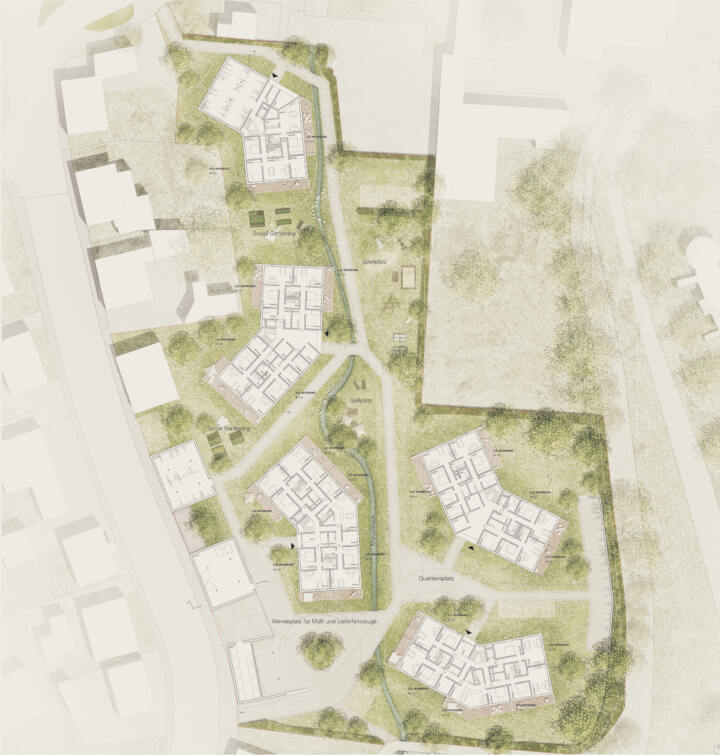
The theme of landscape runs throughout the entire residential quarter, and assembling the residential buildings in a meandering arrangement helps to give contour to the overall urban structure. The screening buildings located along Kemptener Strasse serve to buffer the area, creating a quieter and more sheltered environment within. It is imperative that the proposed apartments should not only be climate friendly, but affordable and attractive too. Responding to the outdoor spaces, apartments are oriented two ways, offering a range of views of the Blasiusberg and historical buildings beyond the immediate neighbourhood. Individual blocks are ideally suited to this, with their compact structure, monolithic construction method and energy efficiency, as well as step-free access.
The current tendency to work from home is taken into account in this forward-looking design concept by providing ‘joker’ rooms that offer people the option to work from home, or to use their space more flexibly. Through a mix of various-sized apartments, a social blend can be created, which helps to underscore the goal of creating stable, communal living.
Through the combination of compact buildings, a simple and thermally robust monolithic construction method, regenerative energy sources, and an energy-efficient BlueGreen building and landscaping concept, this project guarantees a forward-looking climate-friendly development.
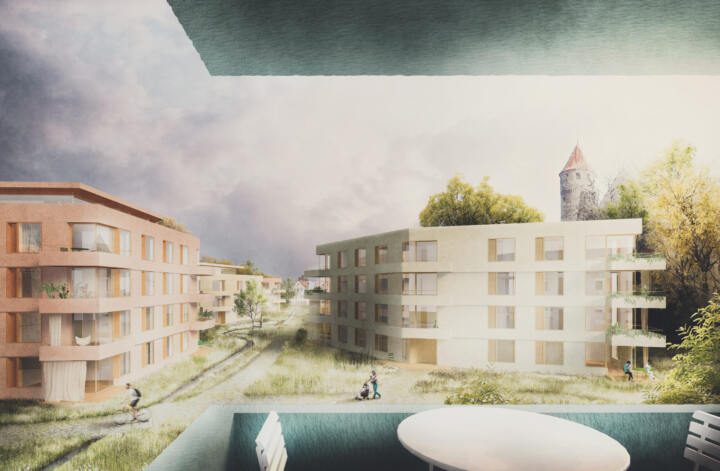
High-Rise Marienplatz| Darmstadt
1.Prize I High-Rise Marienplatz
Darmstadt
This new high-rise building creates a link between Darmstadt’s publishing district and the city centre, while anchoring the project in the existing urban context.
The characteristic profile of the high-rise, with the lower four storeys set back, will make it a prestigious address for both residences and offices. The high-rise consists of a 4-storey plinth base, plus a 12-storey block rising from it. The plinth mirrors the eaves height of the neighbouring building thus establishing a relationship with its urban context. The top of plinth is planted with a roof garden that corresponds with its neighbour too. Another feature of the high-rise block are the 1.7m deep balconies that run round the building. Permanently installed planters here are intensively planted, engendering a garden-like atmosphere, shading the façade and creating a microclimate. This greenery is further enhanced by a generous roof area, the distinctive design of the terraces, and a row of trees along the outer edge of the penthouse terrace. The aim is to use all resources judiciously in order to create a sustainable building.
The space surrounding the building is typified by a square with some areas covered in grass pavers, and informal groups of trees. Benches beneath them are designed to encourage people to linger a while. Bicycle parking is arranged along the façade and the traffic routes. The green façade at ground floor level helps to tie the external landscaping into the building.
Cuno-Raabe School | Fulda
1.Prize + Surcharge I Cuno-Raabe School
Fulda
The redesign of the Cuno-Raabe School in Fulda encompasses a wide range of issues. Alongside erecting buildings, establishing fire compartments and escape routes, and generating an energy concept for the buildings, the external spaces offer high-quality, efficient and sustainable design. All this presents an opportunity to put the former church – a heritage listed building with a strong identity – to a new use.
The new building, which forms the northwest extremity of the site, is being developed in conjunction with the existing church building. To bring together various internal uses – such as classrooms, admin rooms, staffrooms, a school canteen, plus a teaching kitchen and other spaces – the church’s volume is to be retained, and inside it a “house-in-house” principle will be applied. While the substance of the church will continue to provide protection from the elements, a separate building that meets the requirements for new sustainable buildings will be built inside. This will later house a school canteen, an auditorium and on the upper floor, a kitchen, areas used throughout the day, and the library. This eliminates the need for a costly energy retrofit. The bridge connecting these two buildings also creates an important external element. A fascinating interplay of façade materials and landscaping is achieved through juxtaposing the materiality of the brick church façade with that of the external areas with alternating wood, textile sunshades, and light concrete block paving.
A core element in the external landscaping concept is the playground between the former church and the new building. Bounded on both sides by stepped seating, it opens up in the centre with space-defining single trees and leads to a dense ‘play forest’ where children can romp around. Another special feature is the climbing and balancing frame that uses gravel incorporated in the subsoil to mitigate the impact of falls. Away from all the hustle and bustle is a quiet area that can also be used as a green classroom or school garden. The planting concept calls for the use of robust native shrubs in the perimeter areas that can withstand all the various demands.
Parking is being restructured in conjunction with the new building. Parking spaces will be supplemented by centrally located bicycle parking close to the entrance. The roofs of the new building, in addition to supporting a modern photovoltaic system for generating power, will be planted as extensive green roofs, plus a landscaped roof garden and a play area.
Millennium Areal | Frankfurt
Recognition I Millennium Areal
Frankfurt
The interplay between green courtyards and stone urban space creates attractive and spatially differentiated outdoor lounges. Loosely set, the multi-stemmed field maples in the courtyard and to the left and right of the entrance plaza form a light-filled canopy that frames and sets the scene for the fountain plaza in front of the main entrance.
A cleverly controlled, flush-to-the-ground fountain and spray field, which can be turned off when needed, together with the bench elements, make the forecourt a popular gathering place. The tree canopies continue into the central courtyard, where loosely placed tree locations are generously underplanted with shade shrubs and ferns. This creates small-scale, green spaces. To make the play area in the kindergarten as contiguous as possible, a linear play and climbing element that accommodates all of the expansive play equipment uses the windowless firewall facing the courtyard.
In the courtyard, the paved amenity areas are reduced and broken up in favor of an even larger greening component.

